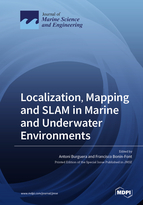Localization, Mapping and SLAM in Marine and Underwater Environments
A special issue of Journal of Marine Science and Engineering (ISSN 2077-1312). This special issue belongs to the section "Ocean Engineering".
Deadline for manuscript submissions: closed (31 October 2020) | Viewed by 24924
Special Issue Editors
Interests: robotics; localization; mapping; SLAM; underwater; sonar; computer vision; artificial intelligence; machine learning; deep learning
Special Issues, Collections and Topics in MDPI journals
Interests: robot vision underwater; mobile robot navigation; localization of underwater robotics; visual simultaneous localization and mapping; convolutional neural networks; underwater inspection and intervention with robots; underwater robotic field applications
Special Issues, Collections and Topics in MDPI journals
Special Issue Information
Dear Colleagues,
The use of robots for field applications in underwater and marine environments is rapidly growing. Tasks such as shipwreck recovery, ocean exploration, biological sampling, and industrial infrastructure inspection, among others, can be achieved thanks to underwater and marine robots.
All these tasks have one common requirement: to properly model the environment and estimate the robots’ poses. Even though several mapping and SLAM methods exist, marine and underwater environments have some particularities that need to be taken into account, such as reduced vision range, water currents, communication problems, sonar inaccuracies, and unstructured environments.
The purpose of this Special Issue is to publish innovative research and application-oriented work related to underwater and marine localization and environment modelling.
Papers related (but not limited) to the following topics will be taken into consideration:
- Marine and underwater localization and SLAM:
- Visual;
- Acoustic;
- Laser based.
- Marine and underwater exploration and mapping:
- Map building;
- 3D ocean floor reconstruction;
- Mosaicking;
- Object and scene recognition.
- Marine and underwater multi-robot and multi-session localization, mapping, and SLAM.
Dr. Francisco Bonin-Font
Guest Editors
Manuscript Submission Information
Manuscripts should be submitted online at www.mdpi.com by registering and logging in to this website. Once you are registered, click here to go to the submission form. Manuscripts can be submitted until the deadline. All submissions that pass pre-check are peer-reviewed. Accepted papers will be published continuously in the journal (as soon as accepted) and will be listed together on the special issue website. Research articles, review articles as well as short communications are invited. For planned papers, a title and short abstract (about 100 words) can be sent to the Editorial Office for announcement on this website.
Submitted manuscripts should not have been published previously, nor be under consideration for publication elsewhere (except conference proceedings papers). All manuscripts are thoroughly refereed through a single-blind peer-review process. A guide for authors and other relevant information for submission of manuscripts is available on the Instructions for Authors page. Journal of Marine Science and Engineering is an international peer-reviewed open access monthly journal published by MDPI.
Please visit the Instructions for Authors page before submitting a manuscript. The Article Processing Charge (APC) for publication in this open access journal is 2600 CHF (Swiss Francs). Submitted papers should be well formatted and use good English. Authors may use MDPI's English editing service prior to publication or during author revisions.
Keywords
- Underwater and marine robotics
- Localization
- Mapping
- SLAM
- Computer vision
- Sonar
- Scene recognition
- Object recognition
- Underwater inspection
- Navigation







